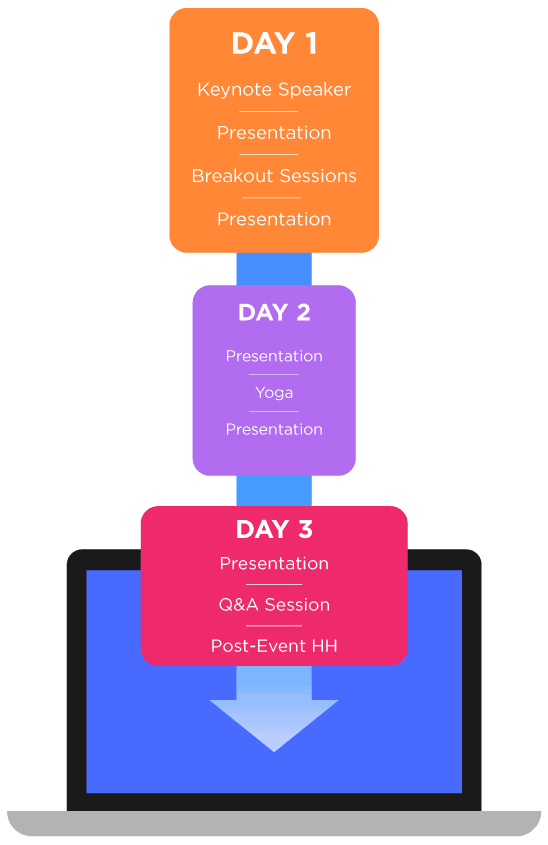From the Outside-In, Virtual Events Can Be Hugely Profitable.
For associations and companies—conferences, business meetings and other industry events are among your most important sources of revenue and customers. And with social distancing measures in place for much of the country, you’ve likely taken some of your events online to help meet your business goals.
Well, here’s a sobering statistic: According to a report by Wild Apricot, in 2019, only 27% of all virtual events hosted by associations made any money at all. And of those, only 12% generated more revenue than their previous in-person event. So, if you’re hoping that virtual events are going to save your bottom line in 2021, you need to start thinking about updating your plans now. This isn’t something you can just expect to fall into place next year.
Here are 5 strategies associations, trade groups and companies can use to create profitable virtual events.
1. Know Your Audience & Map Desired Engagement.
Your audiences attend events for several different reasons—for networking, education, resetting on what’s current. And in the past, your events may have delivered the right mix to meet their needs. Perhaps you used the same general format for all of your events—some topic overviews, a few deep dives, and a couple of diversions to lighten the mood and create social currency and connections.
But audience expectations may have shifted since the COVID-19 restrictions. Perhaps some of the features that made your event special in the past aren’t valued as highly anymore. Your audience may not be as interested in seeing famous keynote speakers who aren’t familiar with the industry and can’t give advice about pressing priorities. Instead, they might be more focused on the day-to-day operations, and want to hear from experts who can offer guidance that they can put to immediate use. Maybe they’re looking to get one-on-one advice from others who have adapted to this new reality. Or perhaps they’re looking for more personalized networking opportunities to deepen their connections with others in the industry. And if you can’t meet their needs, they won’t show up.
The key is to make sure you know your audience and what they value. Don’t make assumptions. Collect feedback or conduct a survey beforehand to make sure you deliver on their needs and expectations. Once you understand your audience and their needs, you’ll be much better prepared to put on a stand-out event!

2. Rethink Your Experience Using Physical to Break Through Virtually.

By definition, your virtual events aren’t going to be the same as your in-person ones. And that’s ok, because each format has different strengths and features that will appeal to your audience – the trick is to use each to its fullest advantage.
You won’t be able to “copy and paste” your previous template into your digital plan. These are two completely different formats that require two completely different approaches.
For one thing, you need to think twice about planning a digital event that spans several days for 8 hours at a time. “Zoom fatigue” is real, and your audience will probably be less than enthusiastic about staring at the computer for hours and days on end. They need to be entertained.
Instead, consider breaking your conference up into much smaller segments that span several days. Having shorter sessions, like 30-60 minute offerings over the course of a week rather than a day or two, can give your audiences enough information to whet their appetite, yet still keep them interested over the long haul. Your audience might even like this format better—the added flexibility will give them the opportunity to fully engage with your event without completely leaving work tasks unattended. Smaller time commitments over more event days also gives you increased measurable data on engagement.
And that brings us to rethinking how you’re going to engage your audience. With in-person events, the interactivity is built-in. Your audience could easily mix and mingle at meals, during scheduled breaks, and at post-event happy hours. But now you’ll need to put some thought into designing that into the virtual experience. Keep your audience engaged with interactive features like polls and surveys during event sessions. Deputizing members as engagement ambassadors. Or get more creative and host a yoga break or virtual contests between sessions to keep your audience energized. Remember, people want some entertainment factor thrown in.
3. Don’t Be Afraid to Charge Fair Market Value. And More on the Next Event.
One of the biggest pitfalls with digital events is not pricing them properly. If you want to make money, you certainly can’t afford to offer them for free or for an unsustainably low cost. Yet many associations do just that. Some associations “undersell” their virtual events, thinking that digital events aren’t as valuable as in-person events. This is a mistake.
Knowing the value that you are providing to both attendees and sponsors is critical. When you produce a high-quality, valuable event and content, you should absolutely charge for what it’s worth. Remember, your audience is also saving money because they don’t have to travel to your venue. And if you want to further make your case to potential attendees, consider offering free or low-charge one-off events prior to the “big” event. When prospects see that you can pull off a quality, short-form digital program, they’ll be much more likely to spend more money on a pricier event for the future.
Finally, consider publishing a donations page for your event. People understand that this has been an especially challenging time for businesses of all types, and businesses are usually eager to support organizations that give them value and the wherewithal to be in business to support members’ businesses. Focusing on the benefits that your event provides can help you make your case and prove your relevance.

4. Create Unique Sponsorship Opportunities.

Just like with your audience, you’ll want to check in with your prospective sponsors to find out about their expectations. Consider doing a listening session or focus group.
What do sponsors need to get out of your events for them to be considered a good investment? Do they crave industry recognition? Or do they want to get in front of interested buyers and leads? Depending on their goals, consider having virtual focus groups or host industry chats that give them an opportunity to demonstrate their thought leadership.
You can also get creative with your sponsorship options. For a bit more fun and whimsy, consider branded experience boxes—packages sent to your participants with surprises that they open at specific points in your event. Free books given by your keynote. Free travel certificates from your meetings partners. Free amazon cards from sponsors. Whatever you offer, note that attendees love winning stuff. And make sure that both you and your sponsors are on the same page—you don’t want to have mismatched expectations.
You may want to reach out to prospective sponsors individually to find out where they stand and how much money is in their sponsorship budget. Then, with this knowledge, you can craft opportunities that are right for your sponsors and intersperse these at your event to enhance the engagement factor. Understanding and addressing the needs of your sponsors is the key to crafting an attractive sponsorship package. In short, make your meetings memorable.
5. Hire an Event Consultant and Use What Ifs to Drive Innovation.
With so much riding on the outcome of your events, you need to set yourself up for success and hire a professional events and marketing team. Experienced event consultants can help you come up with some disruptive creative ideas, create an experience that rivals your in-person event from the past and finally develop some new communications to drive home “this isn’t your grandpappy’s tradeshow or conference.
An agency from the outside looking in can help you spread the word about your event on social media and with email marketing. Plus they can help you produce engaging feature videos and custom-made “thank you” gifts that make a positive, lasting impression on your audience.




